



The share of investors under the age of 30 years in India’s equity markets edged down slightly to 38.9 percent in July even as experts say this is neither a major shift nor a cause for concern since fresh registrations from this age group remained robust, reflecting continued interest and engagement in the equity market.
More importantly, however, the dip comes after years of steady growth. Data from the latest NSE Market Pulse report shows the under-30 group saw a decline from 39.5 percent in March. This marks the first dip after several years of steady growth, during which the segment rose from 22.6 percent in March 2019 to nearly 40 percent by March 2024.

A large section of experts believes the decline largely reflects the current market environment rather than waning youth interest. Trivesh D, COO of broking platform Tradejini explains that the sideways market has prompted some investors to pause or exit temporarily.
“When the market rallies, they will return. Older investors, on the other hand, are more focused on long-term investment and understand the limitations of short-term play,” he said, adding that the pandemic had spurred a surge of young investors, driven by liquidity and the F&O boom.
Meanwhile, overall momentum remains slower than last year. The NSE report also noted that between April and July, 48 lakh investors joined, compared to 78 lakh in the same period of FY25. Monthly additions averaged 12.4 lakh, below FY25’s 19.8 lakh. Analysts attribute the slowdown to global headwinds, including geopolitical tensions and retaliatory tariffs, though the recent rebound reflects continued investor confidence.
Some of the shift is also attributed to a natural consequence of age progression. Gurpreet Singh Sidana, CEO of Religare Broking, pointed out that as investors grow older, they move into the next age bracket, which naturally lowers the cumulative share of the under-30 cohort.
“If new investor acquisition among under-30s had also slowed, the drop would have been sharper. But fresh registrations remain strong, including in the 30-plus category, so this isn’t a concern. The trend is strengthening — the cumulative number falls only because people age. For those under 30, the percentage is largely stable or gradually increasing,” he said.
After a subdued start to FY26, registrations rebounded in July with 15.1 lakh new investors added, a 19 percent month-on-month increase and the highest in six months. This lifted NSE’s registered investor base to 11.8 crore, while unique trading accounts crossed the 23 crore mark.
Trivesh added that despite reports indicating 91 percent of retail F&O traders lost money in FY25, with aggregate losses exceeding Rs 1.8 lakh crore over three years, fresh entrants continue to be drawn by social media buzz, real-time success stories, and rising aspirations.

NSE data further shows that the median age climbed to 33 years, up from 32 in the previous fiscal, while the mean rose to 36. Growth in the broader under-40 cohort, which makes up more than two-thirds of investors, slowed to 4 percent in the first four months of FY26, compared to 9.1 percent a year earlier.
UP leads new investors, women gain ground
Uttar Pradesh contributed the largest share of new investors in July at 13 percent, followed by Maharashtra (12 percent), Gujarat (8 percent), and Tamil Nadu and West Bengal (7 percent each). Regionally, West India led with a 31.5 percent month-on-month surge.
Female participation continued its steady climb, reaching 24.6 percent of NSE’s investor base in July, up from 16.9 percent in FY23. Goa (32.8 percent), Mizoram (32.3 percent), Chandigarh (32.1 percent), and Sikkim (30.4 percent) lead on gender parity, while Maharashtra (28.5 percent) and Gujarat (26.6 percent) top the larger states. Uttar Pradesh, despite having the second-largest base, trails at 18.8 percent, though up from 16.9 percent in FY23. More than half of India’s states (53 percent) now report female participation above the national average, compared to 44 percent two years ago.
Trivesh also noted that the investor base is evolving into a healthier, more balanced structure. “Older investors are holding on to SIPs, ETFs, and goal-based plans, while young investors are more risk-aware yet eager to experiment. Fixed deposits are no longer their fallback; they want equities and derivatives to grow wealth. This is not a pullback; it’s the maturation of a more disciplined and sustainable retail investor base, focused on long-term thinking rather than short-term hype,” he said.
Disclaimer: The views and investment tips expressed by investment experts on Moneycontrol.com are their own and not those of the website or its management. Moneycontrol.com advises users to check with certified experts before taking any investment decisions.
Discover the latest Business News, Sensex, and Nifty updates. Obtain Personal Finance insights, tax queries, and expert opinions on Moneycontrol or download the Moneycontrol App to stay updated!
Find the best of Al News in one place, specially curated for you every weekend.
Stay on top of the latest tech trends and biggest startup news.